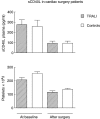Lack of evidence of CD40 ligand involvement in transfusion-related acute lung injury
- PMID: 21605114
- PMCID: PMC3142652
- DOI: 10.1111/j.1365-2249.2011.04422.x
Lack of evidence of CD40 ligand involvement in transfusion-related acute lung injury
Abstract
Activated platelets have been implicated in playing a major role in transfusion-related acute lung injury (TRALI), as platelets can trigger neutrophils, resulting in vascular damage. We hypothesized that binding of platelet CD40 ligand (CD40L) to endothelial CD40 is essential in the onset of TRALI. Mice were challenged with monoclonal major histocompatibility complex (MHC)-1 antibody which induced TRALI, evidenced by pulmonary oedema, accompanied by significantly elevated bronchoalveolar fluid (BALF) levels of total protein and elevated plasma levels of keratinocyte-derived chemokine (KC) and macrophage inflammatory protein-2 (MIP-2) compared to infusion of isotype antibody (all Ps < 0·05). Treatment with ciglitazone, which inhibits platelet CD40L expression, had no effect on pulmonary and systemic inflammation compared to controls. In addition, treatment with anti-CD40L antibody, which antagonizes all CD40-CD40L interactions, also did not abrogate the TRALI reaction. Furthermore, levels of soluble CD40L were measured in a cohort of cardiac surgery patients, who were followed prospectively for the onset of TRALI after transfusion. Plasma levels of sCD40L at baseline and at time of developing TRALI did not differ between TRALI patients and controls (transfused cardiac surgery patients not developing acute lung injury) (275 ± 192 versus 258 ± 346 and 93 ± 82 versus 93 ± 123 pg/ml, respectively, not significant). In conclusion, these results do not support the idea that the CD40-CD40L interaction is involved in mediating TRALI.
© 2011 The Authors. Clinical and Experimental Immunology © 2011 British Society for Immunology.
Figures



Similar articles
-
Evidence of CD40L/CD40 pathway involvement in experimental transfusion-related acute lung injury.Sci Rep. 2019 Aug 29;9(1):12536. doi: 10.1038/s41598-019-49040-0. Sci Rep. 2019. PMID: 31467410 Free PMC article.
-
Accumulation of CD62P during storage of apheresis platelet concentrates and the role of CD62P in transfusion-related acute lung injury.Mol Med Rep. 2015 Nov;12(5):7777-81. doi: 10.3892/mmr.2015.4347. Epub 2015 Sep 22. Mol Med Rep. 2015. PMID: 26397744
-
Soluble CD40 ligand accumulates in stored blood components, primes neutrophils through CD40, and is a potential cofactor in the development of transfusion-related acute lung injury.Blood. 2006 Oct 1;108(7):2455-62. doi: 10.1182/blood-2006-04-017251. Epub 2006 Jun 13. Blood. 2006. PMID: 16772606 Free PMC article.
-
The signaling role of CD40 ligand in platelet biology and in platelet component transfusion.Int J Mol Sci. 2014 Dec 3;15(12):22342-64. doi: 10.3390/ijms151222342. Int J Mol Sci. 2014. PMID: 25479079 Free PMC article. Review.
-
The platelet as an immune cell-CD40 ligand and transfusion immunomodulation.Immunol Res. 2009 Dec;45(2-3):251-60. doi: 10.1007/s12026-009-8106-9. Epub 2009 Jan 29. Immunol Res. 2009. PMID: 19184537 Free PMC article. Review.
Cited by
-
Antiplatelet antibody may cause delayed transfusion-related acute lung injury.Int J Gen Med. 2011;4:677-80. doi: 10.2147/IJGM.S23220. Epub 2011 Sep 12. Int J Gen Med. 2011. PMID: 21941454 Free PMC article.
-
CD40 ligand (CD154) involvement in platelet transfusion reactions.Transfus Clin Biol. 2012 Jun;19(3):98-103. doi: 10.1016/j.tracli.2012.02.003. Epub 2012 Jun 14. Transfus Clin Biol. 2012. PMID: 22703674 Free PMC article. Review.
-
Evidence of CD40L/CD40 pathway involvement in experimental transfusion-related acute lung injury.Sci Rep. 2019 Aug 29;9(1):12536. doi: 10.1038/s41598-019-49040-0. Sci Rep. 2019. PMID: 31467410 Free PMC article.
-
Transfusion of target antigens to preimmunized recipients: a new mechanism in transfusion-related acute lung injury.Blood Adv. 2021 Oct 26;5(20):3975-3985. doi: 10.1182/bloodadvances.2020003843. Blood Adv. 2021. PMID: 34438443 Free PMC article.
-
The pro-inflammatory effects of platelet contamination in plasma and mitigation strategies for avoidance.Vox Sang. 2012 May;102(4):345-53. doi: 10.1111/j.1423-0410.2011.01559.x. Epub 2011 Nov 18. Vox Sang. 2012. PMID: 22092073 Free PMC article.
References
-
- Goldman M, Webert KE, Arnold DM, Freedman J, Hannon J, Blajchman MA. Proceedings of a consensus conference: towards an understanding of TRALI. Transfus Med Rev. 2005;19:2–31. - PubMed
-
- Silliman CC. The two-event model of transfusion-related acute lung injury. Crit Care Med. 2006;34:S124–S131. - PubMed
-
- Silliman CC, Boshkov LK, Mehdizadehkashi Z, et al. Transfusion-related acute lung injury: epidemiology and a prospective analysis of etiologic factors. Blood. 2003;101:454–62. - PubMed
-
- Bux J. Antibody-mediated (immune) transfusion-related acute lung injury. Vox Sang. 2011;100:122–8. - PubMed
-
- Silliman CC, Paterson AJ, Dickey WO, et al. The association of biologically active lipids with the development of transfusion-related acute lung injury: a retrospective study. Transfusion. 1997;37:719–26. - PubMed
MeSH terms
Substances
LinkOut - more resources
Full Text Sources
Medical
Research Materials

